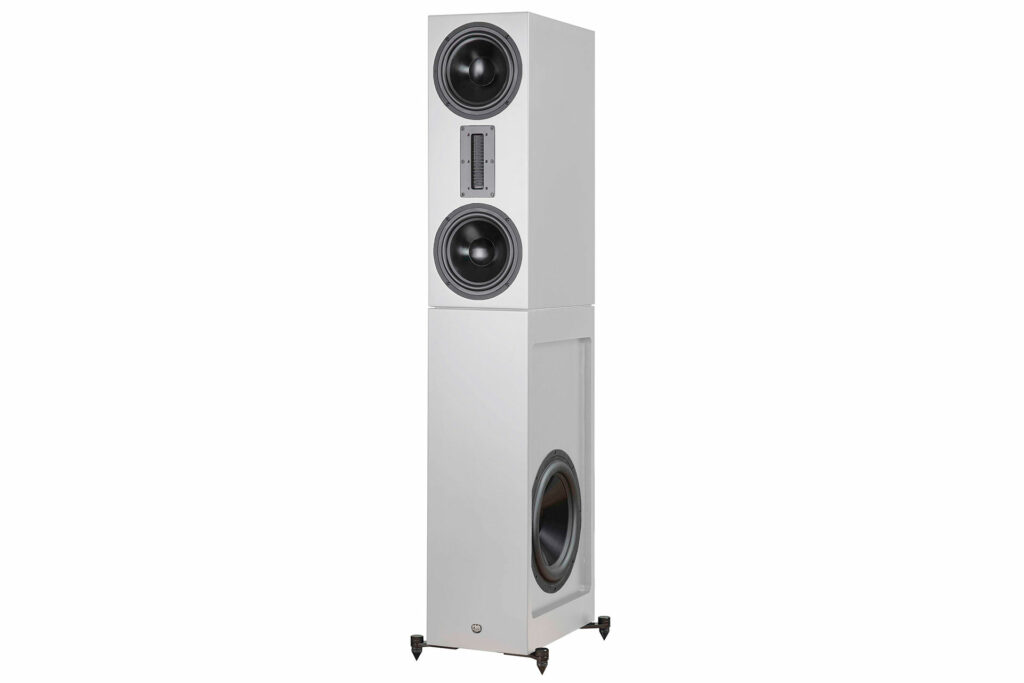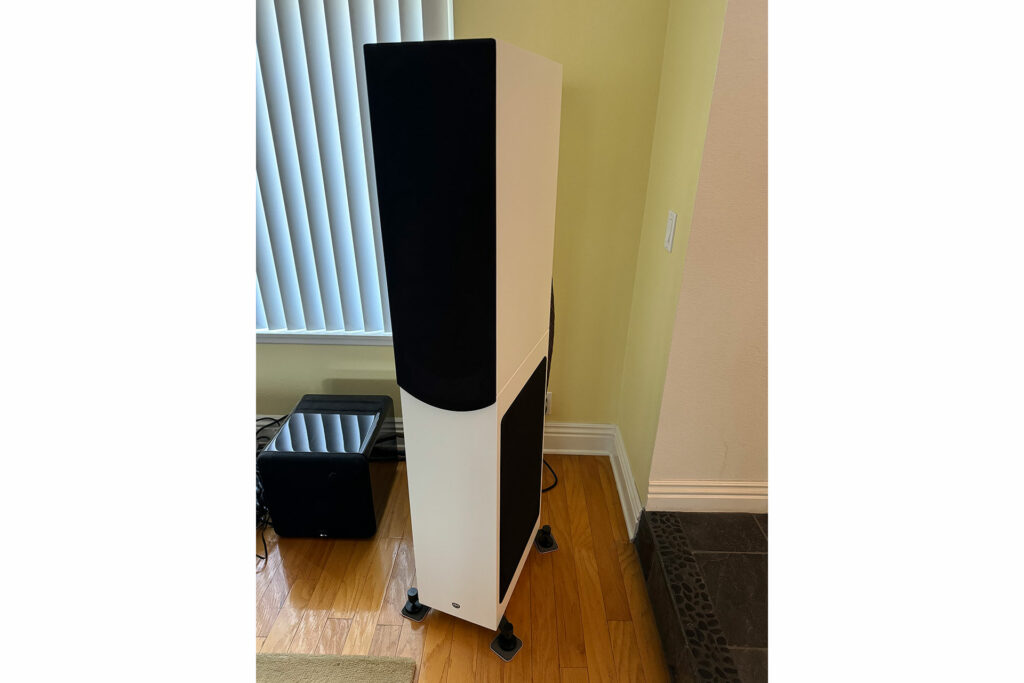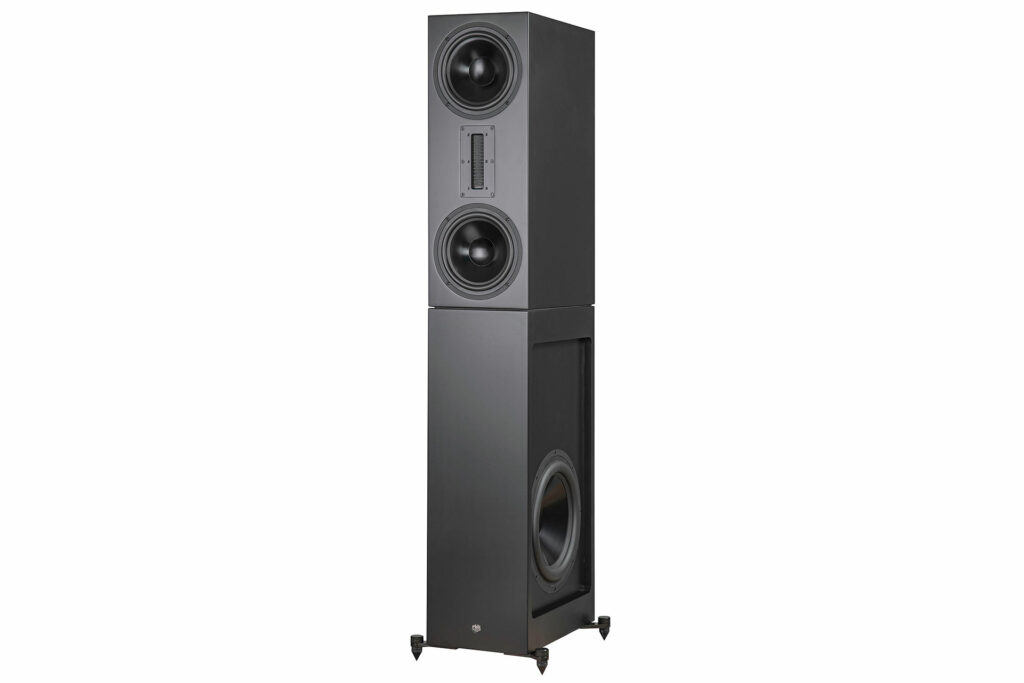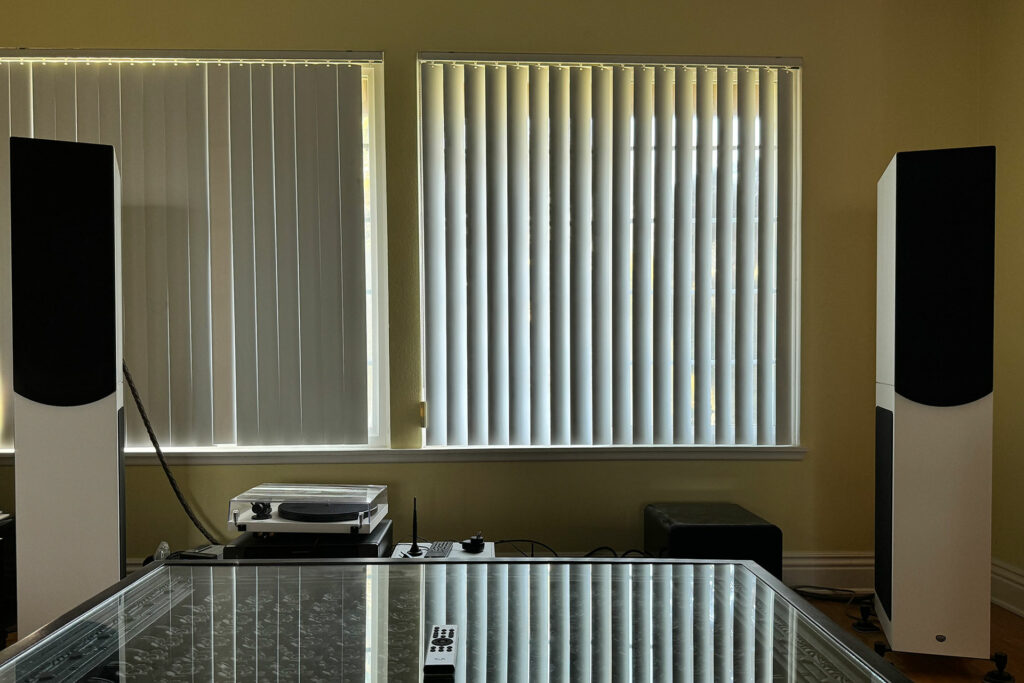Last year, I reviewed RBH Sound’s SVTR fully active speaker system. They are a monster in terms of performance, size and is pretty expensive at approximately $40,000 per pair, depending on configuration. While I was working on that review, I learned about a new, smaller and less expensive speaker system that was touted as being the spiritual “little brother” to the RBH SVTR. The RBH SFTR reviewed here at $16,500 per pair (about $2,000 less with fewer, included amps aka the DA-2602DSP from RBH) is without question physically smaller, less expensive, and appears to share some of the same technological advantages of the SVTR, but I was curious to see what would carry over when it actually came to listening to the SFTRs.
RBH’s Vice President of Engineering and Technical Director, Shane Rich, physically delivered the speakers to my house and helped me set them up. The SFTR is offered in several configurations. I choose the variant RBH feels will be most popular, which is from the reference line, and with the internal subwoofer amplifier. The reference line version is also available with an external rack-mounted amplifier. If you feel the need to kick it up a notch, RBH’s Unrivaled product line features upgraded cabinet construction, Kimber wiring and other tweaks. The Unrivaled version is available in passive or fully active versions. The fully active version comes with outboard amplification and signal processing, which appears to be similar to that in the SVTR system I previously reviewed.

What Makes the SFTR Loudspeakers Special?
- If RBH’s claims are accurate, the SFTRs offers much of the SVTR’s performance in a smaller size and at a reduced price. What is not to like about that? The question is, does the SFTR deliver the goods? Read on to find out.
- The SFTR may be smaller than its big brother but it is still a larger speaker at 57 ¾ inches tall, 13 1/4 inches wide (with outrigger feet, 9 ¾ inches without) and 17 inches deep, weighing in at 137 pounds per side. Each side is composed of two cabinets, which makes it easier to ship them and get them into position, especially if stairs are involved. The relatively narrow front baffle has a magnetically attached black grille, which covers the top module and has a semi-circular bottom, which extends a couple of inches down in front of the bottom module, which hides the joint line, making the speakers appear as one unit from the front. The sides of the bottom module have large grille cloth inserts on each side to cover the side-firing woofers.
- The top module is RBH’s 821-SF/R, which has one tweeter flanked by a pair of eight-inch, aluminum-coned mid-woofers in a D’appolito configuration. The tweeter is the same Aurum Cantus Air Motion Tweeter aka “AMT,” co-designed with RBH, that is found in the larger SVTR towers, but the eight-inch mid-woofers are a slightly different design optimized for this application.
- The bottom module is RBH’s 1212-MS/R, which features powerful, dual 12-inch, aluminum cone drivers, one firing to each side. The back panel has the RBH plate amplifier, with 2,400 watts of power and a DSP system, which will be set up by your RBH dealer.
- RBH specifies the frequency response as 20Hz-35kHz +/- 3dB with 92 dB (2.83V at one meter) sensitivity. The impedance of the 821 module is stated as six ohms nominal with the woofer module at four ohms. RBH recommends 100-350 watts per channel for the 821 tweeter midrange module.
- The RBH SFTR cabinets are made in the United States out of high-density fiberboard, and are finished in satin white or black. While the fit and finish are nice but they just recently started offering custom colors. You need to call your dealer to get a quote on how much a pair of RBH SFTRs cost in Rosa Forte (Ferrari racing red) or Bugatti blue but don’t worry – RBH can paint these speakers in any color you can dream of.
- The RBH Sound SFTR speakers rest on newly-designed outriggers with adjustable feet.This system provides stability and makes leveling quick and easy. For those with little kids and/or pets, this is a major problem avoided. Read Jerry Del Colliano’s article here about Baby Proofing Your Audiophile System here.

Why Should You Care About the RBH SFTR AMT Speakers?
RBH’s SFTR system provides most of the performance of its flagship system in a smaller, less expensive package. Depending on the configuration, you may give up some of the DSP capabilities, but you will retain them for the critical, room-dependent bass range. If your room is problematic, or you simply wish to experiment, opt for the fully active version with full-range processing. As for any sacrifice due to reduced size, unless you are in an extremely large room and need the extra bass output capabilities, you are likely not losing out on any output capability that you would actually use. In fact, there may be some advantages to the SFTR’s streamlined configuration, as discussed below.

Some Things You Might Not Like About the RBH SFTR Speakers
- The aesthetics of these speakers potentially may be divisive. I personally really liked their clean modern lines, but my wife thought they were less attractive, especially with the contrasting black grilles on the front and sides of a white speaker. Perhaps the all-black would have been less intrusive?
- While my review speakers were from early production and did not come with owner’s manuals (and none are on the RBH website yet either, but likely pending), I understand from watching Shane that the processor in the internal subwoofer amplifier is probably not something most listeners would be able to easily adjust. If you are one of the tech-savvy audiophiles, I am sure that you will be able to navigate the DSP to tweak it as much as you desire. However, if you are the average listener who wants to auto-calibrate after moving the speakers or switch between presets using an app on your iPhone, you will not be able to do so.
- Vertical dispersion is limited, due in large part to the driver configuration. This may cause problems depending on the placement requirements of your room, and may require you to tilt the speakers to get within the optimum listening window.
Listening to the RBH SVTR Audiophile Loudspeakers…
I did my listening with these speakers in my larger living room, which opens into adjacent rooms. This system featured an Eversolo DMP-A6 Master Edition (on loan from RBH – review from Greg Handy pending, too) for the source and a two-channel RBH amplifier driving the top module. The amplifier utilizes Pascal, Class-D amplification rated at 500 watts into four ohms or 250 watts into eight ohms.
Comparing the SFTRs to the bigger SVTRs was one of the first things I wanted to do. With that in mind, the first track I will discuss here is one I used in my SVTR review. I even used the Marantz SACD 30n (read my review) as a source for a bit to make conditions as similar as possible.
“Lost Without You” by Freya Riding sounded similar, but not quite the same through both speakers. The biggest difference I found was that the SFTR was slightly more forward in the higher frequencies. I thought that the RBH SFTR would be lacking bass in comparison to the SVTRs, as the SFTRs were in a bigger room and had a sealed cabinet, but nope, the SFTRs produced plenty of deep and detailed bass. As with the SVTRs, the SFTRs did a very good job disappearing into the sonic landscape rather than being the obvious source of the sound. On this track and others, I found individual voices and instruments to be slightly better defined in space, and that the sharp imaging was more forgiving of lateral change in listening position.
As my son is learning to play guitar, we have been listening to a lot of music featuring excellent guitar work. One newer piece which caught both of our attention was the instant audiophile classic, aka: Marcin’s rendition of “Kashmir.” This young guitar virtuoso plays his acoustic guitar with a unique percussive fingerstyle in a reverb-inducing concrete parking structure to great effect. Listening to this track though the SFTRs was exciting and often led to me playing the track a few more times. The combination of detail, balance, weight and dynamics was impressive.
I have spent many hours listening to a wide variety of music through these RBH speakers, and found that they appropriately scale the soundstage to the recording, with individual sources being well-defined. However, on large-scale orchestral pieces, the SVTRs (in the same room) produced a larger soundstage. Voices were produced naturally, and details were not hidden or veiled whatsoever. The RBH SFTRs are very revealing, especially in the treble. This is great with well-recorded music, but will reveal the flaws in subpar recordings.
It was only at very high volumes with bass-heavy tracks, such as Ghost Rider’s “Make Us Stronger,” that the larger cabinet size and porting of the SVTRs provided an audible output advantage. I never felt the lesser number of mid-woofers to be limiting the output or performance of the smaller SFTRs.

Do the RBH SFTR Loudspeakers Have Any Resale Value?
This is a pretty easy: yes. Likely more so than the larger SVTRs, as more rooms will be able to accommodate their smaller size. Speakers and amplifiers evolve more slowly than most other audio/video components. As noted in a prior article, the one component of the system that I was most concerned about is the digital controller. In the SVTR, the digital controller is a separate unit. In the version of the SFTR reviewed here, it is built into the internal amplifier. However, so long as it remains operational, I do not see a downside, as it appears to have plenty of functionality. In the event there is some breakthrough new technology, one can always set the internal processing to bypass most adjustments and use whatever new outboard processor that has become the flavor of the day.
Who Is the Competition For the RBH SFTR Floorstanding Speakers?
The Legacy Audio AERIS at $21,975 again come to mind, as it also uses an AMT for the highs and lows are handled by a pair of 12-inch woofers. Legacy’s optional Wavelet provides feature-rich processing to the entire frequency range, not just the subwoofers. I have not been fortunate enough to have spent time with them, but my experience with other Legacy Audio speakers has been positive.
ATC makes a wide variety of well-regarded active speakers, but they do not have the advanced signal processing of the RBH SVTR; you would have to bring in your own processor, such as one of the excellent Trinnov units like the example. KEF has also become a bigger player on the active speaker market, with their wireless LS60 towers ($4,999 buy at Crutchfield) having built-in streaming capabilities, but lacking the power and extension of the RBHs.

Final Thoughts on the RBH SFTR Loudspeakers…
When first speaking with RBH about the smaller (but not that small overall) version of the SVTR and its “reduced output” capabilities, I was a bit concerned that the SFTRs would not be able to rock the house. I had absolutely nothing to worry about on that front. Moving from a fully active to a partially active speaker, you do lose some control and the ability to customize the sound to your particular environment and tastes. Thankfully, the most severe room interactions are in the bass region, which retains the active signal processing, and the passive module is well-balanced, so long as you are within the vertical listening window. If not, this is easily rectified with the adjustable feet.
The RBH SFTR is very revealing and detailed, perhaps even more so than the SVTR. Listening to the SFTR, I found individual notes to be precisely rendered with great control. String instruments were rendered with great detail and texture, adding realism to the reproduction. Despite lacking the infinite adjustability of the fully active SVTRs, I spent a great deal of time exploring new music with the SFTRs, finding them to provide a dynamic and engaging experience. These are truly fantastic speakers for the modern audiophile that will last for decades and provide tremendous musical enjoyment.



